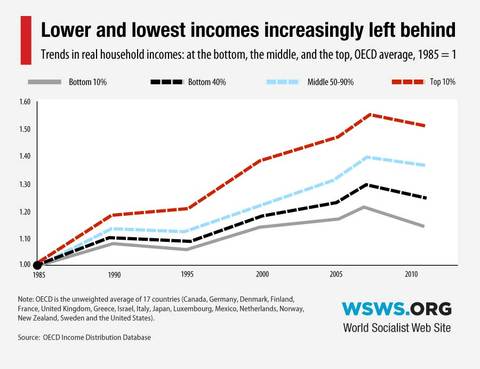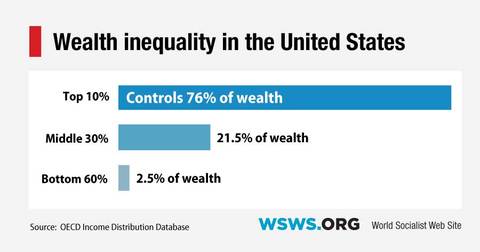OECD Report: Global Social Inequality Hits New Record
By Gabriel Black
23 May, 2015
WSWS.org
Income inequality in many developed countries has reached an all-time high, according to a report released Thursday by the Organization for Economic Co-operation and Development (OECD). The report also notes that growth of social inequality has been accompanied by the growth of part-time and contingent labor, particularly for younger workers.

The wealthiest tenth of the population in OECD member countries now earn 9.6 times the income of the poorest 10 percent, up from nine times in the 2000s, and seven times in the 1980s.
“Inequality in OECD countries is at its highest since records began,” said OECD Secretary-General Angela Gurria. The OECD is composed of 34 advanced economies, including the United States, members of the European Union, Japan, Korea, Mexico and several others.
The report notes that in 2012, “the bottom 40% owned only 3% of total household wealth in the 18 OECD countries with comparable data. By contrast, the top 10% controlled half of all total household wealth and the wealthiest 1% owned 18%.”
The United States is the fourth most unequal country in the OECD, after Chile, Mexico and Turkey.
In the mid-1980s, the top 10 percent of US income earners took in 11 times more than the bottom 20 percent. This figure rose to 12.5 times in the mid-1990s, but in 2013, the US’s top 10 percent made 19 times more than the bottom 10 percent.
Wealth inequality in the United States is even greater than income inequality. In the US, the top 10 percent controls 76 percent of all the wealth, while the bottom 60 percent owns just 2.5 percent. The top five percent of households in the US have about 91 times more wealth than the average household.

For the OECD countries as a whole, the top 10 percent of the population owns 50 percent of the wealth. The middle 50 percent owns about 47 percent of the wealth, and the bottom 40 percent owns just three percent.
A large portion of this increase in income inequality has occurred in the aftermath of the 2008 financial crisis. According to the report, in the United States, “between 2007 and 2013, net wealth fell on average 2.3 percent, but it fell ten-times more (26 percent) for those at the bottom 20 percent of the distribution.”
Income inequality in the United States is substantially worse than in any other developed country. For instance, while overall household income is 14 percent higher in the US compared to Canada and 25 percent higher compared to Germany and France, the report notes that “the average income of the bottom 10% in the US is 42% lower than in Canada and about 50% lower than in France and Germany.”
The OECD claims that one reason for this difference is that “redistribution through income taxes and cash transfers is considerably lower in the United States than in most other OECD countries.”
The report notes the particular hardship that the lowest-earning sections of the international working class have faced in the past 30 years. In the past three decades “low-income households have not benefited at all from income growth.” For instance, the bottom 10 percent of income earners in the United States lost 3.3 percent of their income since 1985, adjusted for inflation, while the average household income increased by 24 percent.
In Spain and several other countries most severely impacted by the financial crisis, this trend was even sharper. Spain saw the incomes of the poorest 10 percent of the population drop by roughly 13 percent every year between 2007 and 2011.
In addition to a massive growth in income and wealth inequality, the report shows that part-time work, self-employment and temporary contracts have become increasingly prevalent over the past two decades. The OECD notes that “Between 1995 and 2013, more than 50 per cent of all jobs created in OECD countries fell into these categories,” adding, “Low-skilled temporary workers, in particular, have much lower and unstable earnings than permanent workers.”
The OECD notes that young people are the most affected by this turn towards temporary, low-paying work. Forty percent of employed young people in the OECD countries, defined as those aged 18 to 34, do not have full-time regular work.
The OECD report calls on governments to take steps to reduce inequality, declaring that, “In recent decades, the effectiveness of redistribution mechanisms has been weakened in many countries.” It warns that “By not addressing inequality, governments are cutting into the social fabric of their countries and hurting their long-term economic growth.”
The reality, however, is that the growth of social inequality is the deliberate outcome of government policies, whose aim has been the enrichment of the financial oligarchy at the direct expense of the working population. No change in this state of affairs is possible within the framework of the capitalist system, whose essential characteristic is the incessant concentration of wealth at the top of society.
Tags
.
Comments are moderated

